

Une lampe de poche immortelle. Voilà un petit moment que je souhaite expérimenter les super-condensateurs (ou supercap, goldcap, supercapacité, ultracap…).

Ce sont des condensateurs qui ont des capacités de stockage énormes par rapport à ce que l'on faisait avant (supérieur au Farad, il y en a certains qui vont jusqu'à 3000 Farads sous 2,7Volts). Je suis donc allé sur Ebay et j'ai acheté un lot de condensateurs 10 Farads en 2,7 volts. Si on fait un petit calcul, un condensateur tel que celui-là peut stocker : E=½ * C * V² soit ½ * 10 *2,7² è 36 Joules soit 1Watt pendant 36 secondes En comparaison, une « pile » rechargeable peut fournir 1 watt pendant 7300 secondes (pour un type AA de 1700mAh) soit 200 fois plus. Cependant, la pile est deux fois plus grande et 4 fois plus lourde. Joule thief. The circuit is variant of the blocking oscillator that forms an unregulated voltage boost converter.

The output voltage is increased at the expense of higher current draw on the input, but the integrated (average) current of the output is lowered and brightness of a luminescence decreased. History[edit] In the "Ingenuity Unlimited" section (readers' ideas) of the November 1999 issue of Everyday Practical Electronics (EPE), page 804, Z. Mag/607PET22a.pdf. Faraday For Fun: An Electronic Batteryless Dice. There has been a lot of interest in muscle powered electronic devices, due in large part to the success of Perpetual TorchPerpetual Torch, also known as battery-less LED torch.
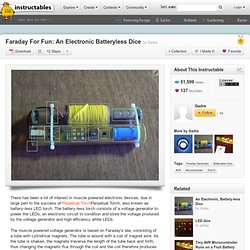
The battery-less torch consists of a voltage generator to power the LEDs, an electronic circuit to condition and store the voltage produced by the voltage generator and high efficiency white LEDs. Solar Charger 200ds230 rev2. Note, a newer version can be found here.
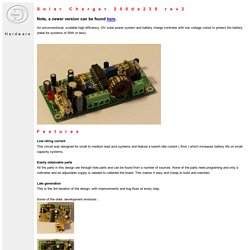
An unconventional, scalable high efficiency 12V solar power system and battery charge controller with low voltage cutout to protect the battery. (ideal for systems of 50W or less) Low idling currentThis circuit was designed for small to medium lead acid systems and feature a lowish idle current ( 5mA ) which increases battery life on small capacity systems. Easily obtainable partsAll the parts in this design are through hole parts and can be found from a number of sources. None of the parts need programing and only a voltmeter and an adjustable supply is needed to calibrate the board. Late generationThis is the 3rd iteration of the design, with improvements and bug fixes at every step. Some of the older, development revisions : Make a simple boost converter. DETECTEUR DE TENSION. XS Boost, A Chef's Salad Solar Robot. Like most robot builders, I tend to accumulate interesting parts and experimental concepts that never end up being necessary in an ordinary robot design.
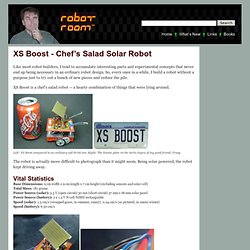
21434g.pdf (application/pdf Object) Power Smart Heads - BEAM Robotics Wiki. From BEAM Robotics Wiki The power smart family of head designs spring from a simple battery-powered design by Wilf Rigter.
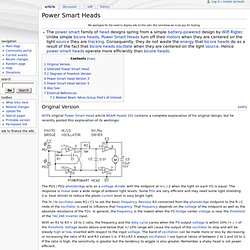
Unlike simple bicore heads, Power Smart Heads turn off their motors when they are centered on the light source they are tracking. Consequently, they do not waste the energy that bicore heads do as a result of the fact that bicore heads oscillate when they are centered on the light source. Hence power smart heads operate more efficiently than bicore heads. [edit] Original Version Wilf's original Power Smart Head article BEAM Heads 101 contains a complete explanation of his original design, but he recently posted this explanation of its workings: The PD1 / PD2 photobridge acts as a voltage divider with the midpoint at Vcc / 2 when the light on each PD is equal. The hi / lo oscillator uses R1 / C1 to set the basic frequency.
Miller Solar Engine - BEAM Robotics Wiki. From BEAM Robotics Wiki Probably the smallest incarnation of the Miller SE, using SMD pieces On December 18, 1999, Dave Hrynkiw announced on the BEAM Email List that Solarbotics had licensed the Miller Solar Engine from Andrew Miller of "AM Innovations".
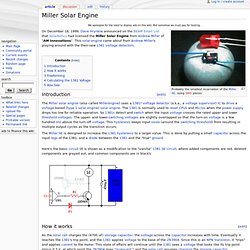
Using a Small Solar Cell and a Supercapacitor in a Wireless Sensor. July 1, 2010By: Pierre Mars, CAP-XX (Australia) Pty.
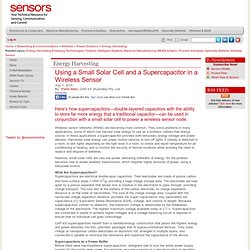
Ltd.Sensors Here's how supercapacitors—double-layered capacitors with the ability to store far more energy that a traditional capacitor—can be used in conjunction with a small solar cell to power a wireless sensor node. Wireless sensor networks (WSNs) are becoming more common. Cds.linear.com/docs/Datasheet/3225fb.pdf. Www.onsemi.com/pub_link/Collateral/MC34063A-D.PDF. Simple DC-DC converter with design tool. The MC34063A is an easy to use DC-DC converter that can be used to step battery voltage up or down to run your processor, small servos or to make an efficient LED spotlight.
The photo shows a kit I bought from Oatley Electronics using this IC and has parts for stepping up or down on the one board. In the photo I'm driving 6x0.5W 10mm LEDs from two AA batteries (3V). This kit is set up to regulate current by regulating the voltage across a shunt resistor but only minor modification is needed to use it as a 5V regulator. The Datasheet also has several sample application circuits complete with board layouts that can step up or down or even invert to supply a negative voltage rail for opamps etc.
Best of all, I've found a simple design tool that displays the apropriate schematic and calculates component values for you. You will need soldering skills to assemble the kit otherwise just get the components from your local supplier and breadboard it. Unusual Components and Applications - WorkbenchFun.com. Negisters, Unijunction transistors, Precision Resistors, and Hall Effect Devices Nothing has impacted our lives more than the electronic devices we now use in our everyday lives.
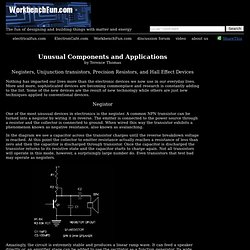
More and more, sophisticated devices are becoming commonplace and research is constantly adding to the list. Some of the new devices are the result of new technology while others are just new techniques applied to conventional devices. Negistor. Super Capacitor in solar power supply - a few queries. I intend to build a remote 'weather station' The station will: Be completley independant of any external power, ie, it will produce its own power via solar cell(s)Measure temperature onlyTransmit its finding over an RF link to an indoors reciever Instead of using a rechargeable battery supply with charger circuit, i have decided to use a 35F, 2.7V super capacitor to smooth and store power.
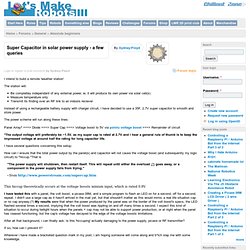
The power scheme will run along these lines: Panel Array* ===> Diode ===> Super Cap ===> Voltage boost to 5V via pololu voltage boost ===> Remainder of circuit *The output voltage will preferably be ~1.5V, as my super cap is rated at 2.7V and i hear a general rule of thumb is to keep the impressed voltage at around half the rating for long capacitor life. I have several questions concerning this setup: 41420C.pdf (application/pdf Object) Boost DC-DC Voltage Regulator Converts To Current Source for Battery Charging. Abstract: A boost DC-DC controller built with the MAX1771 DC-DC controller makes a simple switch-mode current source that is useful for battery charging. The voltage control loop is disabled so that the current control loop provides regulation.
The switching regulator of Figure 1 includes independent loops of current and voltage feedback for maintaining regulation. By disabling the voltage loop, you can use the current loop to implement a general-purpose current source. Figure 1. Pololu Adjustable Boost Regulator 4-25V. This powerful, adjustable boost regulator can generate an output voltage as high as 25 V from an input voltage as low as 1.5 V, all in a compact, 0.42″ x 0.88″ x 0.23″ package. Boost converter. A boost converter (step-up converter) is a DC-to-DC power converter with an output voltage greater than its input voltage. It is a class of switched-mode power supply (SMPS) containing at least two semiconductors (a diode and a transistor) and at least one energy storage element, a capacitor, inductor, or the two in combination.
Filters made of capacitors (sometimes in combination with inductors) are normally added to the output of the converter to reduce output voltage ripple. The basic schematic of a boost converter. The switch is typically a MOSFET, IGBT, or BJT. Overview[edit] Power for the boost converter can come from any suitable DC sources, such as batteries, solar panels, rectifiers and DC generators. ) must be conserved, the output current is lower than the source current. History[edit] Re:Solar USB Charger - UltraCapacitors.org - Ultra Capacitor - Super Capacitors - Super Battery? New project: solar rover based on Picaxe 18X. Power Supply 5v Solar/TITLE> HOW THE CIRCUIT WORKS The circuit consists of an oscillator transistor and a regulator transistor. The solar panel charges the battery when sunlight is bright enough to produce a voltage above 1.9v.
A diode is required between the panel and the battery as it leaks about 1mA from the battery when it is not illuminated. The regulator transistor is designed to limit the output voltage to 5v. This voltage will be maintained over the capability of the circuit, which is about 10mA. The oscillator transistor must be a high-current type as is is turned on for a very short period of time to saturate the core of the transformer. Supercapacitors [Archive] - PICAXE Forum. I've been a great supercap. fan for years, & all manner of electrical party tricks are possible with them.
A classic involves connecting a small efficient DC motor, spinning it with your fingers as a generator, then having the stored energy (re)drive the motor. Why their PICAXE appeal however? They certainly will run PICAXEs, but their stored energy is pretty small compared with say a Li coin cell. Of course (compared with Li cells), that 30 Ohm internal resistance may be a bonus, as it limits the current should some stupid short develop. Pololu 5V Boost Regulator NCP1402.
The Forever Rechargeable VARIABLE Super Capacitor Battery !!! Www.herjulf.net/ultracapacitors/capbal/balancing circuit measurements v_0_2.pdf. Charging supercapacitor banks needs careful consideration of the power supply. Statement of the problem. 5v Solar Supply. TE Index for website.